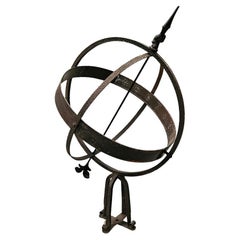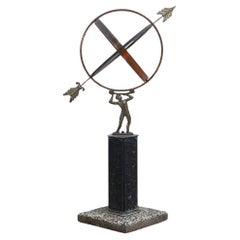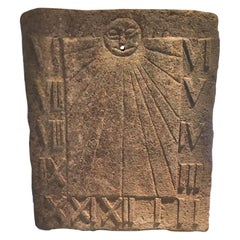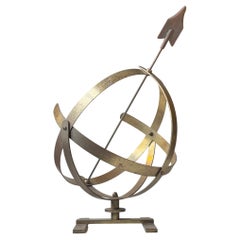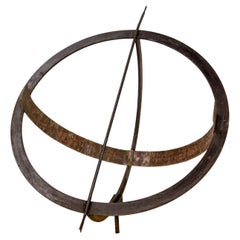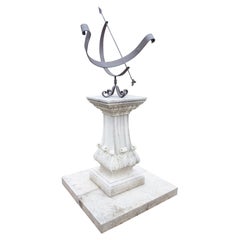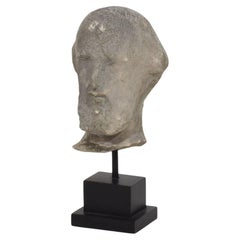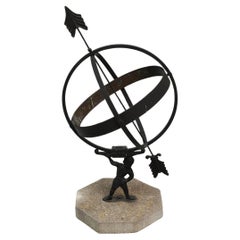Continental Europe - Sundials
to
8
45
31
8
Height
to
Width
to
1
1
2
2
4
3
2
5
3
3
2
1
6
3
2
2
8
8
8
Item Ships From: Continental Europe
Swedish Atlas Astrology Garden Armillary
Located in Vienna, AT
A Swedish garden armillary, manufactured in the 1950s in Sweden.
Category
1950s Swedish Vintage Continental Europe - Sundials
Materials
Brass
Swedish Atlas Astrology Garden Armillary
Located in Vienna, AT
A Swedish garden armillary on a metal base made of metal and cement plate. Total height approx. 132 cm.
Category
1950s Swedish Vintage Continental Europe - Sundials
Materials
Multi-gemstone, Brass
18th Century French Stone Sundial
Located in Vosselaar, BE
A impressive late 18th century French sandstone sundial mounted on a custom lade iron stand. The Latin numerals finely carved at both sides an...
Category
Late 18th Century French Neoclassical Antique Continental Europe - Sundials
Materials
Sandstone
Vintage Scandinavian Nautical Sundial in Brass, 1950s
Located in Esbjerg, DK
A stylish and large in- or outdoor sundial fashioned from solid brass. It was made on order to an Institution in Stockholm Sweden circa 1946-52. Measurements: H: 48 cm, Diameter: 31 ...
Category
Mid-20th Century Scandinavian Mid-Century Modern Continental Europe - Sundials
Materials
Brass
Postmodern Glass Sundial from Royal Leerdam Crystal
Located in Hamburg, DE
Postmodern Glass Sundial from Royal Leerdam Crystal, in None conditions. Designed 1980 to 1989.
Additional information:
Materials: Glass
Styles: Postmodern
Item Type: Vintage, Antiq...
Category
20th Century Post-Modern Continental Europe - Sundials
Materials
Glass
French Antique Copper & Iron Garden Sundial late 19th Century
Located in Labrit, Landes
Antique Garden sundial, in Iron and Cooper to be embedded in the support of your choise.
The Roman numerals engraved on the copper band are use...
Category
1890s French Antique Continental Europe - Sundials
Materials
Copper, Iron
Large Tower Clock by H. Wheight, Malmesbury (1859) – Fully Functional
Located in Madrid, ES
Product Overview: An exceptional find for antique clock collectors and enthusiasts, this large tower clock dates back to 1859, crafted by H. Wheight of Malmesbury. The clock is in pe...
Category
1850s Antique Continental Europe - Sundials
Materials
Wrought Iron
Slate Sundial, Decorated And Dated 1704
Located in MARSEILLE, FR
Slate sundial engraved and decorated with cornucopias, shells and a crown topped with the motto "In Hoc Signo Vinces", which can be translated as "by this sign you will overcome" and...
Category
Early 18th Century European Louis XIV Antique Continental Europe - Sundials
Materials
Slate
Related Items
Large Italian Limestone Garden Armillary Sundial with Acanthus Carvings
Located in Dallas, TX
More information coming soon…
Measuring almost seven feet tall, this towering armillary sundial would make a wonderful garden ornament. Hand-carved in Italy, the tall base, which i...
Category
21st Century and Contemporary Italian Continental Europe - Sundials
Materials
Stone, Limestone, Metal, Iron
$7,900
H 83.25 in W 39.375 in D 39.125 in
Small 18th Century French Carved Stone Baroque Head Of A Saint
Located in Buisson, FR
Lovely small carved stone head of a Saint with a great expression.
France, circa 1750. Weathered. measurements include the wooden base
H:20cm W:8,5cm D:10,5cm
Category
18th Century French Baroque Antique Continental Europe - Sundials
Materials
Stone
$353 Sale Price
48% Off
H 7.88 in W 3.35 in D 4.14 in
Italian 18th Century Chalk/ Cast Stone Angel Head
Located in Buisson, FR
Wonderful chalk/ cast stone angel head.
Italy circa 1750
Weathered, small losses.
Measurements include the wooden base.
H:20cm W:11cm D:10cm
Category
18th Century Italian Baroque Antique Continental Europe - Sundials
Materials
Stone
$593 Sale Price
43% Off
H 7.88 in W 4.34 in D 3.94 in
18th Century French Wrought-Iron Dragon Weathervane
Located in Chicago, IL
A stunning and rare 18th century French hand-wrought iron weathervane, from Normandy, with a stylized dragon "flag" the moves according the wind, and with four wrought-iron flowers t...
Category
18th Century French Primitive Antique Continental Europe - Sundials
Materials
Wrought Iron
Carved Italian Marble Sundial with Iron Gnomon
Located in Dallas, TX
Hand-carved in Italy, this beautiful marble sundial has a turned iron gnomon that mirrors a thin twisted rope molding along the outer edges. Beneath the gnomon attachment are colored inserts that form a blue, red, yellow, and green compass rose, providing a colorful contrast to the cream marble with subtle tan and gray veining.
As the earth rotates on its axis, the gnomon casts a shadow onto the marble which is incised with Roman Numerals on a stylized scroll. Directly under the tip of the angled gnomon is “XII”, indicating noon. The numbers to the left of XII run counterclockwise, starting with “VI”. On the opposite side, the numerals continue in a counterclockwise manner, terminating in a second “VI” (which would be PM if the sundial...
Category
21st Century and Contemporary Italian Continental Europe - Sundials
Materials
Marble, Iron
French, 18th Century Carved Stone Head Fragment
Located in Buisson, FR
Magnificent carved stone head fragment with a very beautiful and strong expression.
France, circa 1750.
Beautiful weathered and small losses.
Measurement is with the wooden base.
H:3...
Category
18th Century French Baroque Antique Continental Europe - Sundials
Materials
Stone
$1,168 Sale Price
48% Off
H 12.6 in W 7.88 in D 5.52 in
Pair 18th Century French Creamware Lions Hand Painted Circa 1790
Located in Katonah, NY
This rare and charming pair of 18th-century French creamware lions was made circa 1790.
Each lion reclines atop a tall rectangular base decorated with rich cobalt-blue swags, bright yellow tassels, and vivid green trim.
The forms are bold and expressive. The lions' open mouths are painted in soft pink, and their manes are rendered in vibrant yellow and lined with dark brown, lending them an animated, almost theatrical presence.
The lions rest on what appear to be stylized, draped cushions, adding a sense of comfort and reality.
Their wide-eyed expressions and exaggerated features give the pair a whimsical character that blends elegance with humor—a hallmark of late 18th-century French design.
Unmarked but unmistakably French in style, these figures make a striking decorative statement. Whether placed on a mantel or console, they command attention and offer a playful counterpoint to more serious classical forms.
Dimensions: 6.5 inches tall x 6.75 inches long x 4.5 inches wide
Condition: Excellent
Price: $2,300
Decoration: Painted in yellow, cobalt, green, pink, and brown with molded drapery and tassel detail
Material: Creamware pottery
Style: French Neoclassical with Folk Art elements
Origin: France
Date: Circa 1790
Key Features
- Rare pair of large 18th-century creamware lion figures
- Expressive hand-painted decoration with bold color contrasts
- Tall bases decorated with molded and painted swags and tassels
- French origin, circa 1790
- Whimsical and animated expressions add charm and visual interest
Background of creamware
Creamware is the name given to a type of earthenware pottery initially made from white clays from Dorset and Devonshire combined with an amount of calcined flint.
Creamware was first produced in England sometime before 1740. Foremost among the pioneers of creamware in the Staffordshire Potteries was Thomas Whieldon. The young Josiah Wedgwood partnered with Thomas Whieldon from 1754 to 1759. When Wedgwood left to set up his own business, he immediately directed his efforts to developing creamware.
Around the same time, in the mid-18th century, French potters developed their creamware known in France as "Faience Fine...
Category
Late 18th Century French Neoclassical Antique Continental Europe - Sundials
Materials
Creamware
$2,300 / set
H 6.5 in W 6.75 in D 4.5 in
Large Armillary Sundial with Cast Iron Pedestal
Located in Wormelow, Herefordshire
Large Armillary Sundial with cast iron pedestal. A Victorian white painted, Cast Iron sundial pedestal. The column is cast with four eagles and leave...
Category
Late 19th Century Antique Continental Europe - Sundials
Materials
Steel, Iron
Pair of 18th Century French Limestone Lions
Located in Los Angeles, CA
A magnificent pair of 18th century French Hand Carved Limestone Lions. The base measurement is 11.5 inches.
Category
18th Century and Earlier French Antique Continental Europe - Sundials
Materials
Limestone
French 18th Century Neoclassical Hand Carved Oak Caryatid Angel Figure
Located in Buisson, FR
Wonderful period piece. Beautiful weathered Neoclassical hand carved oak caryatid angel figure.
Weathered. france circa 1780
H:34,5cm W:10cm D:5,5cm
Category
18th Century French Neoclassical Antique Continental Europe - Sundials
Materials
Oak
$509 Sale Price
46% Off
H 13.59 in W 3.94 in D 1.97 in
Atlas Armillary Sundial in Pewter Finish with Brass Accents
Located in Stamford, CT
The Greeks have used sundials to measure time since 100 B.C. Reminiscent of classic Greek mythology, this Atlas Armillary Sundial will demand attention, ...
Category
2010s Indian Continental Europe - Sundials
Materials
Aluminum, Brass
$176 Sale Price / item
20% Off
H 28 in W 27 in D 16 in
18th Century Italian Carved Figure
Located in Los Angeles, CA
From a beautiful home in Santa Barbara. Not sure if paint is original, but it is definitely old. Finely carved with a lot of character.
Category
18th Century Italian Neoclassical Antique Continental Europe - Sundials
Materials
Wood, Paint
Previously Available Items
Swedish Atlas Astrology Garden Armillary
Located in Vienna, AT
A Swedish garden armillary on a metal base made of metal and cement plate. Total height approx. 86 cm.
Category
1950s Swedish Vintage Continental Europe - Sundials
Materials
Multi-gemstone, Brass
Sculpture French “Armillary sundial”, Bronze and stone, midcentury
By French House & Garden
Located in Valladolid, ES
“Armillary sundial” sculpture, Bronze and stone, mid-20th century – France
Ancient sculpture from the mid-20th century, known as an armillary sundial. It is a piece in good condition...
Category
1930s French Art Deco Vintage Continental Europe - Sundials
Materials
Stone, Bronze
Vintage Swedish Atlas Armillary Sundial Attributed to Sune Roth
By Sune Rooth
Located in Bochum, NRW
Vintage Original Sun Clock or Armillary Sun Dial attributed to Sune Rooth, mid-20th century.
Antique garden ornament from Sweden, known as a Sun Clock or Armillary Sun dial, with a c...
Category
1940s European Art Deco Vintage Continental Europe - Sundials
Materials
Copper, Wrought Iron
Swedish Atlas Astrology Garden Armillary & Stone Pedestal
Located in Vienna, AT
A Swedish garden armillary flared base having seated on cast hard stone balustrade pedestal, 20th century.
Category
1950s Swedish Vintage Continental Europe - Sundials
Materials
Multi-gemstone, Brass
19th Century Compass Sundial, Jacque Linedal, Dieppe, France
By Jacques Linedal
Located in Milan, IT
A 19th century silvered and gilt-brass horizontal compass-sundial, signed Jacques Linedal fecit a Dieppe Lat. 49, with folding scroll support gnomon, the compass with a blued needle,...
Category
19th Century French Antique Continental Europe - Sundials
Materials
Brass
12th Century Sandstone Zodiac Sundial
Located in Vosselaar, BE
A impressive and intriguing Spanish Zodiac dating back to the Romanesque period. This architectural fragment would originally have been part of the facade of a aristocratic house or the inner walls of a cloister. Knowledge of the Zodiac was the privilege of the upper classes and only kept alive trough the efforts of monks who safeguarded (and hid at the same time) books and manuscripts since antiquity.
This example is very rare, not only because of its age and size but also because it combines a Zodiac with a sundial. It is executed with great care and eye for proportion.
The sculpture was originally made out of two vertical slabs tightly positioned next each other. We fixed both stones together and finished with a natural mortar in between as they did in the 12th century...
Category
15th Century and Earlier Spanish Medieval Antique Continental Europe - Sundials
Materials
Sandstone
Large Scale Steel Armillary Sphere Sundial with Gold Leaf Gilt Details
Located in Casteren, NL
A beautiful large scale is armillary in metal with a central sphere depicting earth.
The arrow is the axis, the earth revolves on. The point, earth, and arrow are gold leaf gilt. T...
Category
Late 20th Century Dutch Continental Europe - Sundials
Materials
Steel, Gold Leaf
12th Century Stone Zodiac Sundial
Located in Vosselaar, BE
A impressive and intriguing Spanish Zodiac dating back to the Romanesque period. This architectural fragment would originally have been part of the facade of a aristocratic house or the inner walls of a cloister. Knowledge of the Zodiac was the privilege of the upper classes and only kept alive trough the efforts of monks who safeguarded (and hid at the same time) books and manuscripts since antiquity.
This example is verry rare, not only because of its age and size but also because it combines a Zodiac with a sundial. It is executed with great care and eye for proportion.
The sculpture was originally made out of two vertical slabs tightly positioned next each other. We fixed both stones together and finished with a natural mortar in between as they did in the 12th century...
Category
15th Century and Earlier Spanish Medieval Antique Continental Europe - Sundials
Materials
Sandstone
Antique Sundial, 1940s
Located in Leuven, Vlaams Gewest
Antique sundial zodiac base cast metal and copper armillary on stone base
This magnificent sundial was made in Finland in the 1940s.
The number...
Category
1940s Finnish Vintage Continental Europe - Sundials
Materials
Metal, Copper
18th Century Slate Stone Sundial
Located in Vosselaar, BE
Intriguing 18th century Italian sundial in slate stone on a custom-made base. All inscriptions on this dial are in French and depict different timezones in Europe. It has beautiful e...
Category
Late 18th Century Italian Neoclassical Antique Continental Europe - Sundials
Materials
Slate
Beautiful Antique Sundial on a Stone Socle
Located in Udenhout, NL
Nice garden item in a very good condition.
Category
Late 19th Century European Antique Continental Europe - Sundials
Early Edition Helix Sundial by Piet Hein for Helios, Denmark, 1986
By Helios, Piet Hein
Located in Wilnis, UT
Rare early edition Helix Sundial designed by Piet Hein for Helios in Denmark, 1986.
Piet Hein designed the sundial in 1986 for the park at Egeskov Castle in Denmark. The unique feature of this sundial is that the shadow-caster and the shadow-catcher have been combined into one unit: a spiral-shaped band (helix) that throws a shadow on itself - a construction that is unique in the 3000-4000 years that man has been making sundials. The dots on the spiral are used as markings to tell the time based on where the shadow line is. This is one of the first of these sundials that was produced, marked number 10 (0010).
In good original condition with minor wear consistent with age and use, preserving a wonderful patina.
Piet Hein has expressed himself throughout his life both as an artist and a scientist. He has been called a universalist. In that way a spiritual affinity existed between him and the Renaissance ideal - a modern variant of Leonardo da Vinci. However, contrary to the historical ideals, in Piet Hein's works is found an easily recognizable element whether it is a matter of scientific publications, essays, poetry or architecture. The special Piet Hein touch is the superiority of the form in relation to the objectives, the medium and - for that matter - the contents.
Piet Hein's world is almost the epitome of design. His recognisable style of language and material turns design into art.
Piet Hein decided to find an absolutely harmonic physical design. With mathematical intuition he first found the form and then explained it afterwards. His superellipse was to solve the double contrast between the circle and the square and that of the ellipse and the rectangle.
Within furniture design the superellipse also became the solution to various problems - especially in relation to Piet Hein's design of tabletops the superellipse became popular.
In a three-dimensional version the superellipse became the superegg which has been used for metal versions of various board games, superegg drink coolers and the anti-stress ball.
Especially the latter reached an enormous distribution in the 1970s. In addition to his work with the development of the superellipse Piet Hein has executed a great many other design commissions, from board games in wood to the elegant Sinus lamp...
Category
Late 20th Century Danish Mid-Century Modern Continental Europe - Sundials
Materials
Steel
Recently Viewed
View AllMore Ways To Browse
Lead Sundial
Bronze Garden Sun Dial
Florentine Lily
Four Seasons Cherubs
Franco Albini Poggi Pavia
Franco Fontana Signed
Francois Remond
French Faux Bamboo Chest
French Faux Bamboo Commode
French Marble Ashtray
French Match Strike
French Rattan Commode
Gabriel Viardot Cabinet
Gabriella Crespi And Dior
Gandhara Sculpture
Garuda Sculpture
General Store Counter
Georg Jensen Silver Tea Pot
